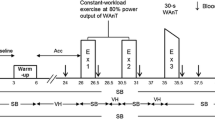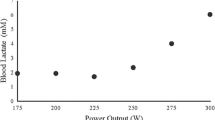Abstract
The purpose of this study is to investigate the responses on cardiorespiratory and metabolic level measured at rest, during a long-term (2 h) submaximal exercise (P=40% Pmax) and during an exhaustive exercise (Vita Max) and recovery time in normal (20‡C) and in hypothermic (0‡C) conditions. The ergometric exercises were performed by 11 male subjects (Vita Max) and 8 male subjects (submaximal exercise) in a climatic room. We have observed a slight but mostly not significant (P<.05) bradycardia for both groups at the end of the exercise. VO2 and pulmonary ventilation are higher at the end of the maximal exercise performed at 0‡C, this phenomenon is reversed for the submaximal exercise. The lactate concentrations are lower at 0‡C. For the same temperature the bicarbonates are higher. pH and T rect are not different in both experimental conditions and RQ is not significantly affected by temperature variations.
Resume
Cette étude a pour but d'étudier les variations physiologiques et métaboliques tant au repos, qu'au cours d'efforts physiques de longue durée (2h) à 40% de la puissance maximale et d'efforts exhaustifs dans des conditions d'hypothermie ambiante (0‡C) en comparaison de valeurs recueillies en conditions thermiques neutres (20‡C). L'ensemble des épreuves furent exécutées en chambre climatique par: d'une part 11 sujets mâles pour l'effort exhaustif et d'autre part 8 sujets mâles pour l'exercice sous-maximal. Nous avons observé une légère bradycardie à 0‡C pour nos deux groupes à la fin de l'effort. La VO2 et la ventilation pulmonaire sont plus élevées à 0‡C lors de l'effort maximal, nous observons toutefois le phénomène inverse lors de l'exercice sousmaximal. Les concentrations plasmatiques en acide lactique sons moins élevées et les bicarbonates plus élevés en ambiance thermique froide pour les deux conditions expérimentales. Le pH et la température rectale demeurent stables. Le RQ ne présente pas de différences significatives à la fin de chacun des deux efforts à 20‡C et 0‡C.
Similar content being viewed by others
Bibliographie
ASTRAND, P., RODAHL, K. (1977): Textbook of work-physiology. McGraw Hill ed., New York.
BROOKS, G., FAHEY, T. (1984): Exercise physiology: Human bioenergetics and its application. J. Wiley and Sons Inc., New York.
BUGUET, A., LIVINGSTONE, S., REED, L., LIMMER, R. (1976): Cold induced shivering in men with thermoneutral skin temperatures. J. Appl. Physiol., 41: 142–145.
CAPUTA, M., CABANAC (1979): Bradycardie during face cooling in man may be produced by selective brain cooling. J. Appl. Physiol., 46: 905–907.
CHIU, D., CHENG, K. (1976): Circulatory changes in cold-acclimation and cold stress. Clin. Exp. Pharm. Physiol., 3: 449–452.
CLAREMONT, A., NAGLE, F., REDDAN, W., BROOKS, G. (1975): Comparison of metabolic, temperature, heart rate and ventilatory responses to exercise at extreme ambiant temperature (0‡C and 35‡C). Med. Sci. Sports, 7: 150–154.
DULAC, S., QUIRION, A., LE BLANC, J., COTE, J. (1982): Effet du vent froid sur la réponse à l'exercice musculaire. J. Can. Sci. Sport, 7: 263–266.
FINK, W., COSTILL, D., VAN HANDEL, P. (1975): Leg muscle metabolism during exercise in the heat and cold. Eur. J. Appl. Physiol., 34: 183–190.
FREY, M., SELM, E., WALTHER, J. (1980): Reflex cardiovascular responses to cold exposure of the face or foot. Jpn. Heart J., 21: 665–679.
FRONDELLE, M., FREUND, H. (1977): Carbohydrate and fat metabolism of unacclimatized man during and after submaximal exercise in cool and hot environment. Europ. J. Appl. Physiol., 31: 23–38.
GRAYSON, J., IRVINE, M., KINNEAR, T. (1966): Observation on temperature distribution in the cardiovascular system. Thorax and abdomen of monkeys, in relation to environment. J. Physiol. (London), 184: 581–593.
HANNA, J., HILL, P., SINCLAIR, J. (1975): Human cardiorespiratory responses to acute cold exposure. Am. Exp. Pharmacol. Physiol., 2: 229–238.
HURLEY, D., TOPLIFF, D., GIRLING, F. (1964): Acute exposure of human subjects to an ambiant temperature of 10‡C. Can. J. Phys. Pharm., 42: 233–243.
KARVONEN, J. (1975): Die Wirkung des kalten Klimas auf Organismus und das Leistungsvermögen. Med. u. Sport, 15, 56–60.
LE BLANC, J. (1975): Man in the Cold. Ch. Thomas ed., Springfield.
LE BLANC, J., BLAIS, B., BARABE, B., COTE, J. (1976): Effects of temperature and wind on facial temperature, heart rate and sensation. J. Appl. Physiol., 40: 127–131.
LE BLANC, J., COTE, J., DULAC, S., DULONG-TURCOT, F. (1978): Effects of age, sex and physical fitness on responses to local cooling. J. Appl. Physiol., 44, 813–817.
LIVINGSTONE, S., GRAYSON, J., FRIM, J., ALLEN, G., LIMMER, R. (1983): Effect of cold exposure on various sites of core temperature measurements. J. Appl. Physiol., 54: 1025–1031.
MATHEW, L., PURKAYASTHA, A., NAYA, S. (1981): Physiological characteristics of cold acclimatization in man. Int. J. Biometeor., 25: 191–198.
McARDLE, W. D., KATCH, F. I., KATCH, V. L. (1981): Exercise physiology: Energy, Nutrition, and Human Performance. Lea and Febiger, Philadelphia.
NIELSEN, B., NIELSEN, M. (1962): Body temperature during work at different environmental temperatures. Acta Physiol. Scand., 56: 120–129.
O'HANLON, J., HORVATH, S. (1970): Changing physiological relationship in men under acute cold stress. Can. J. Physiol., 48: 1–10.
RAVEN, P., NIKI, I., DAHMS, T., HORVATH, S. (1970): Compensatory cardiovascular responses during an environmental cold stress. (5‡C). J. Appl. Physiol., 29: 417–43.
REFSUM, H., TVEIT, B., MEEN, H., STROMME, S. (1973): Serum electrolyte fluid and acid-base balance after prolonged heavy exercise at low environmental temperature. Scand. J. Clin. Lab. Invest., 32: 117–122.
RIGGS, C., JOHNSON, D., KONOPKA, B., KILGOUR, R. (1981): Exercise heart rate to facial cooling. Eur. J. Appl. Physiol., 37: 323–330.
ROWELL, L. (1974): Human cardiovascular adjustments to exercise and thermal stress. Physiol. Rev., 54: 75–159.
SHVARTZ, E., GLICK, Z., MAGAZANIK, A. (1977): Response to temperature, cold and hot environments and the effects of physiological training. Aviat. Space Environ. Med., 48: 254–260.
S'JONGERS, J., SEGERS, M. (1969): Normes fonctionnelles cardio-vasculaires du sportif au repos et à l'effort. Acta Belg. Arte Med. Pharm. Milit., 15: 48–54.
SPURR, J., HORVATH, S., HAMILTON, L., HUTT, B. (1956): Temperature gradients in the hypothermic dog. Am. J. Physiol., 186: 47–51.
STROMME, S., LANGE ANDERSEN, K., ELSNER, R. (1963): Metabolic and thermal responses to muscular exertion in the cold. J. Appl. Physiol., 18: 756–763.
VON EULER, U. (1974): Sympatho-adrenal activity in physical exercise. Med. Sci. Sports, 6: 165–173.
Author information
Authors and Affiliations
Rights and permissions
About this article
Cite this article
Vogelaere, P., Quirion, A., Leclercq, R. et al. Variations cardio-respiratoires et metaboliques à l'effort sous-maximal (P=40% Pmax) et maximal (Vita Max) en conditions thermiques froide (0‡C) et neutre (20‡C). Int J Biometeorol 30, 91–106 (1986). https://doi.org/10.1007/BF02189448
Received:
Issue Date:
DOI: https://doi.org/10.1007/BF02189448




